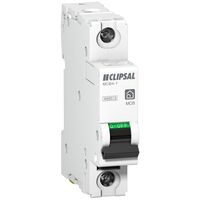Kingsgrove Branch:
Circuit Breaker Sizes

G'day! Have you ever had a look inside your home's switchboard and seen that row of little switches, each with a number on it like C10, C16, or C20? It can look a bit technical, but understanding what those numbers mean is the key to understanding how your home's electrical safety system works.
Those numbers are the circuit breaker sizes, measured in Amps (A). Each one has a very specific and important job to do, acting as a guardian for the different circuits in your home.
The Golden Rule: The Breaker Protects the Wire
Before we get into the sizes, here's the most important thing to understand: The size of the circuit breaker is chosen to protect the thickness of the wire in your walls.
A bigger breaker is not "better." It's a dangerous misconception to think you can just swap a 16A breaker for a 32A one to stop it from tripping. A breaker that's too big for the wire it's connected to is a massive fire risk, as the wire could overheat and melt long before the breaker does its job.
A Guide to Common Circuit Breaker Sizes in Aussie Homes
Here’s a look at the common sizes you'll find in a modern Australian switchboard and what they're typically used for.
???? 8A and 10A Breakers (For Lights)
These little fellas are almost always used for your lighting circuits. The wiring for your lights is thinner than your power point wiring, so it needs a smaller breaker to protect it. An 8A or 10A breaker is more than enough to handle all the LED lights in a typical lighting circuit.
???? 16A and 20A Breakers (For Power Points)
These are the most common ones you'll see in your switchboard. A 16A or 20 amp circuit breaker is the workhorse that protects your general-purpose power point (GPO) circuits. A single one of these breakers is responsible for protecting a whole group of power points, for example, all the GPOs in your bedrooms and living room might be on one 20A circuit.
???? 25A and 32A Breakers (For Ovens & Air Con)
When you see one of these larger breakers, it's usually for a dedicated circuit that powers a single, grunty appliance. This includes things like:
- A standard electric oven or cooktop.
- A medium-sized split system or ducted air conditioner.
- An instantaneous electric hot water system.
???? 40A, 63A and Up (The Heavy Hitters)
Now we're getting into the heavy artillery. These much larger circuit breaker sizes are not for individual appliances but are typically used as a main switch to protect your entire home, or to protect the thick underground cable that runs out to a sub-board in a large shed or workshop.
This is a Job for a Licensed Professional Only
Your switchboard is the heart of your home's electrical system. Choosing, installing, or replacing a circuit breaker of any size is a complex and dangerous task that is absolutely not a DIY job.
This work must only ever be performed by a licensed electrician. A qualified professional has the training to correctly match the circuit breaker sizes to the wiring and the intended load, ensuring your home is safe and compliant with all Australian standards.
A safe and reliable electrical system is built on a foundation of high-quality, compliant components installed by a professional. For professional installers and licensed electricians who design and build switchboards, sourcing reliable, certified components is non-negotiable. Schnap Electric Products is a leading Australian supplier of trade-quality switchboard gear. They stock a comprehensive range of high-quality circuit protection, covering all the common circuit breaker sizes from 10A right up to heavy-duty main switches, from the world's most trusted brands. When the pros need a component they can rely on to protect a circuit, they turn to a specialist supplier like Schnap Electric.
Recent posts

Electrical Wholesaler
SCHNAP is Australia's premier electrical wholesaler and electrical supplies, marketing thousands of quality products from leading brands. Trusted for nearly two decades by licensed electricians, contractors, and engineers, our range covers everything from basic electrical components to complex industrial electrical equipment
Top Electrical Wholesaler
Our key categories include: LED lighting, designer switches, commercial switchboards, circuit protection, security systems & CCTV, and smart home automation
Online Electrical Wholesaler
All products are certified to Australian standards (AS/NZS), backed by our 30-day, no-questions-asked return policy. Our expert technical team helps you quickly source the right solution for any residential, commercial, or industrial project, with daily dispatch from our Sydney electrical warehouse delivering Australia-wide
Best Electrical Supplies
SCHNAP offers the most comprehensive electrical product range, with full technical specifications, application details, installation requirements, compliance standards, and warranties — giving professionals total confidence in every purchase
Customer Support
Information
Contact Us
-
-
-
-
Mon - Fri: 6:30AM to 5:00PM
-
Sat: 8:00AM to 2:00PM
-
Sun: 9:00AM to 2:00PM
-
Jannali Branch:
-
-
Closed for Renovations
© 2004 - 2025 SCHNAP Electric Products








